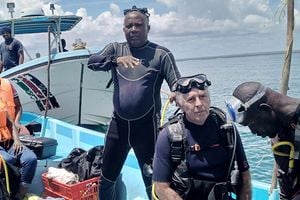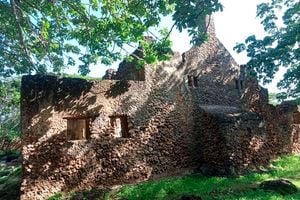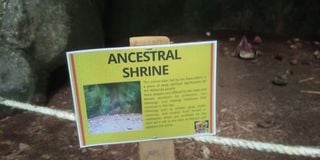
The Panga ya Saidi archaeological caves in Kauma sub-County in Kilifi on December 20, 2024.
In June 2021, the fossils of a three-year-old male child dating back 78,000 years were found in a grave at the Panga ya Saidi caves in Kilifi County.
The fossils are said to be the oldest human remains in Africa.
A grave in the caves also contained the fossils of an adult man and some artefacts buried 400 years ago.
Four years later, the site is yet to be gazetted by the national government. The family of the late Ibrahim Said Musuko from the Kauma sub-County who own the land, has since started managing the site privately.
Although the fossils from Panga ya Saidi are at the laboratories of the National Research Centre on Human Evolution (CENIEH) in Burgos, Spain, for further excavation, treatment and analysis, the family says they have come up with strategies to market the site as a tourist destination.
The initiative to make the Panga ya Saidi caves an international tourist site is spearheaded by the grandchildren of the late Mzee Musuko— the children of his first son.
Family spokesperson Samwel Musuko Shoka said there were indications that the government had no plans to market the Panga ya Saidi historical site, prompting the family to look for ways of making use of the resources.
“We saw the need for us to partner with other like-minded individuals to market this historical site to the world for our community and future generations,” he said.
He disclosed that at some point, the Kilifi county government had shown interest in developing infrastructure in the historical site, but there were no plans and budget to market the place as a tourist destination.
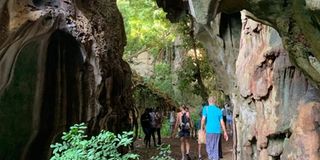
Tourists inside the Panga ya Saidi archaeological cave in the Kauma sub-County in Kilifi during the launch of the caves as a tourist site on December 20, 2024.
This led the family to decline the offer since they saw that it would not benefit the community.
“There was a proposed budget of Sh20 million for the construction of a road and toilets but nothing to promote and market the historical site for the benefit of the community,” he said.
Mr Shoka said the family would still allow the community to hold traditional prayers in the caves.
However, due to the massive investments in the caves, they will be controlled and not access the area freely as before.
“We have made massive investments in the caves that we need to protect, and therefore, we will set some terms for those coming to conduct their prayers here,” he said.
Part of the initiative involves inviting artistes to tell stories about the Mijikenda culture in a creative way at the caves.
Ms Mara Menzies, known by her artist Mara the Storyteller, said they wanted to use art and storytelling to tell about the Panga ya Saidi caves and the Mijikenda culture and heritage.
“I stayed abroad and they value their story so much, unlike in Kenya where we don’t care about our culture and very few people are interested but we are losing it because the elderly are dying with their wisdom and knowledge,” she said.
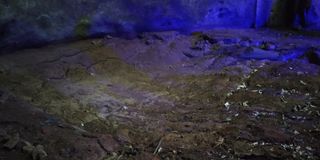
A grave containing the bones of a three-year-old male child buried 78,000 years ago was found in the Panga ya Saidi archaeological caves in Kauma sub-County in Kilifi on December 20, 2024.
She stated that it is currently difficult for people to tell the story of the Mijikenda community.
Whenever communities from different parts tour the Coast, they are forced to search and the information is not easily available to the public.
The initiative also aims to nurture talents among the youth and school children to embrace art.
“I see this as a problem because even people come from abroad and what they only know is ‘Jambo Bwana’, nothing much. They have a good time and go back to their country without having any information about the Mijikenda culture,” she said.
Mara, the storyteller, said they would bring on board other people to hold shows and do more stories.
She called on the government to support the initiative to promote tourism.
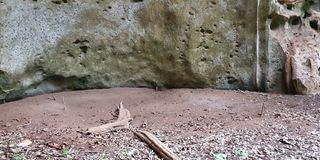
A grave containing the bones of a three-year-old male child buried 78,000 years ago was found in the Panga ya Saidi archaeological caves in Kauma sub-County in Kilifi on December 20, 2024.
Mr Shoka said the family would enter into a Memorandum of Understanding with the artists on how to share the benefits. However, he said the information was confidential.
National Museums of Kenya Head of Department of Earth Sciences Emmanuel Ndiema said Panga ya Saidi was still under investigation.
“There is more to be unearthed and tell the story. The site was not gazetted and therefore was not a government property. The archaeological remains are the ones protected by law,” he said.
Dr Ndiema said after the investigations, which might take a year or two, the National Museum of Kenya, in consultation with the County government of Kilifi, will gazette the site as a national heritage site.
He said the National Museum of Kenya was not aware of the new developments since it was private property.
A report by the United Nations Educational, Scientific and Cultural Organisation (Unesco) detailed the significance of the findings at Panga ya Saidi.
According to the report, the interdisciplinary archaeological investigations carried out by the Max Planck Institute for the Science of Human History, in partnership with the National Museums of Kenya, have helped in understanding the Middle to the later Stone Age technological transition.
Investigations have also focused on the role of the site in the late Holocene agricultural and trading networks along the Swahili coast.
The report further stated that the Ancient DNA recovered from a 400-year-old burial indicated that the individual was closely related to ancient and present-day hunter-gatherers in eastern Africa, including the ancient individual at Motta, Ethiopia.
mongala@ke.nationmedia.com


